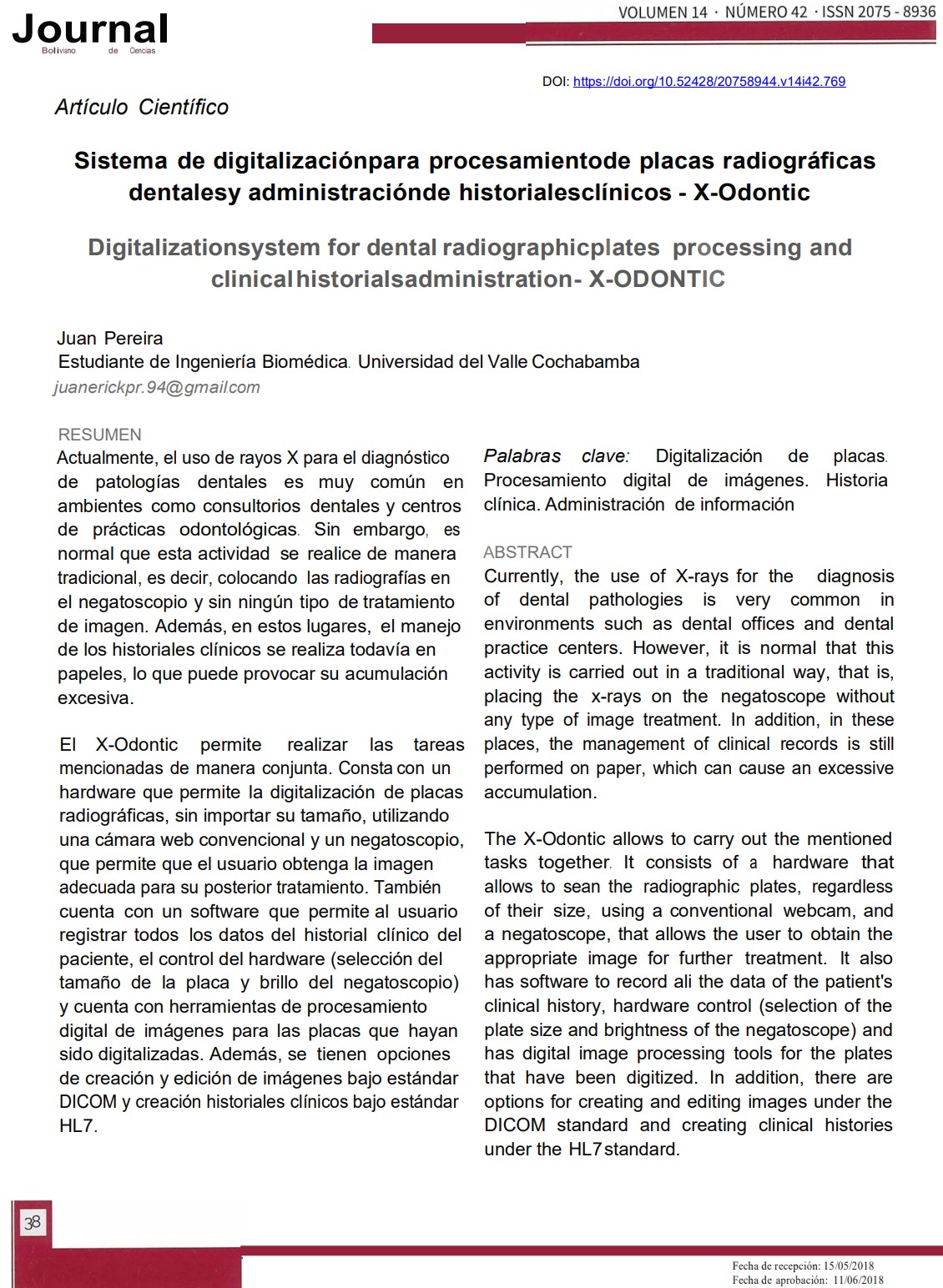Digitalization System for Dental Radiographic Plates Processing and Clinical Historials Administration - X-Odontic
DOI:
https://doi.org/10.52428/20758944.v14i42.769Keywords:
Digitalization of Plates, Digital Image Processing, Clinical History, lnformation ManagementAbstract
Currently, the use of X-rays for the diagnosis of dental pathologies is very common in environments such as dental offices and dental practice centers. However, it is normal that this activity is carried out in a traditional way, that is, placing the x-rays on the negatoscope without any type of image treatment. In addition, in these places, the management of clinical records is still performed on paper, which can cause an excessive accumulation. The X-Odontic allows to carry out the mentioned tasks together. lt consists of a hardware that allows to sean the radiographic plates, regardless of their size, using a conventional webcam, and a negatoscope, that allows the user to obtain the appropriate image for further treatment. lt also has software to record ali the data of the patient's clinical history, hardware control (selection of the plate size and brightness of the negatoscope) and has digital image processing tools for the plates that have been digitized. In addition, there are options for creating and editing images under the DICOM standard and creating clínical histories underthe HL7 standard.
Downloads
References
(1) Gonzáles, F. (2015). Uso controlado de los rayos X en la práctica odontológica. Colombia: Universidad del Rosario. Recuperado el 16 de mayo de 2018 de: http://revistas.urosario.edu.co/index.php/revsalud/article/view/3655
(2) Basterra l. (2011). Teledetección-lmágenes satelitales-Procesamiento digital de imágenes. Argentina: Universidad del Nordeste. Recuperado el 27 de noviembre de 2017 de: http://ing.unne.edu.ar/dep/goeciencias/fotointer/pub/teoria2011/parte02/tdi.pdf
(3) Keller, S. (2012). Análisis de rendimiento entre la base de datos relacional: MySQL y una base de datos no relacional: MongoDB. Ecuador: Universidad del Azuay. Recuperado el 16 de mayo de 2018 de: http://dspace.uazuay.edu.ec/bitstream/datos/5319/1/11698.pdf
(4) CCEEM {Centro de Control Estatal de Equipos Médicos de Cuba) (1998). Control de calidad de cuartos oscuros y dispositivos de visualización de imagen. Cuba: Centro de Control Estatal de Equipos Médicos de Cuba. Recuperado el 16 de mayo de 2018 de: http://www.iaea.org/inis/collection/NCLCollectionStore/_Public/46/105/46105537.pdf

Downloads
Published
How to Cite
Issue
Section
License
Copyright (c) 2018 Juan Pereira

This work is licensed under a Creative Commons Attribution 4.0 International License.
Authors who publish with this journal agree to the following terms:
- Authors retain copyright and grant the journal right of first publication with the work simultaneously licensed under a Creative Commons Attribution License 4.0 that allows others to share the work with an acknowledgement of the work's authorship and initial publication in this journal.
- Authors are able to enter into separate, additional contractual arrangements for the non-exclusive distribution of the journal's published version of the work (e.g., post it to an institutional repository or publish it in a book), with an acknowledgement of its initial publication in this journal.
- Authors are permitted and encouraged to post their work online (e.g., in institutional repositories or on their website) prior to and during the submission process, as it can lead to productive exchanges, as well as earlier and greater citation of published work.














